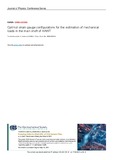Mostrar el registro sencillo del ítem
Optimal strain gauge configurations for the estimation of mechanical loads in the main shaft of HAWT
| dc.creator | Iriarte Goñi, Xabier | es_ES |
| dc.creator | Aginaga García, Jokin | es_ES |
| dc.creator | Lerga Valencia, Francisco Javier | es_ES |
| dc.creator | Gainza González, Gorka | es_ES |
| dc.creator | Ros Ganuza, Javier | es_ES |
| dc.creator | Bacaicoa Díaz, Julen | es_ES |
| dc.date.accessioned | 2021-06-25T12:34:22Z | |
| dc.date.available | 2021-06-25T12:34:22Z | |
| dc.date.issued | 2020 | |
| dc.identifier.issn | 1742-6588 | |
| dc.identifier.uri | https://hdl.handle.net/2454/40053 | |
| dc.description | Trabajo presentado a Science of Making Torque from Wind 2020, TORQUE 2020 | es_ES |
| dc.description | Incluye póster | es_ES |
| dc.description.abstract | In Structural Health Monitoring of wind turbines, measuring the mechanical loads is a key issue. The customary techniques for this task use a full-bridge strain gauge configuration to measure each of the six load components exerted on the shaft. However, using only six strain gauges should be sufficient to estimate the six load components if a one-to-one correspondence was achieved. In this paper a different approach to mechanical loads estimation is presented where, measuring the strain of individual gauges in quarter-bridge configurations, it is possible to estimate all the load components from a single set of gauges. The configurations are optimally determined making use of the D-optimality criterion, which maximises the observability of the estimated components. The approach also provides configurations where the apparent strain related to temperature variations is automatically compensated. Results show several optimal configurations for different measuring conditions and shows that six strain gauges are enough to estimate all the load components. The new approach also opens the possibility to obtain configurations with more strain gauges as well as configurations that have to meet other requirements. | en |
| dc.format.extent | 12 p. | |
| dc.format.mimetype | application/pdf | en |
| dc.language.iso | eng | en |
| dc.publisher | IOP Publishing | en |
| dc.relation.ispartof | Journal of Physics: Conference Series, 1618 (2020) 022034 | en |
| dc.rights | Creative Commons Attribution 3.0 Unported (CC BY 3.0) | en |
| dc.rights.uri | http://creativecommons.org/licenses/by/3.0/ | |
| dc.subject | Mechanical loads | en |
| dc.subject | Strain gauges | en |
| dc.title | Optimal strain gauge configurations for the estimation of mechanical loads in the main shaft of HAWT | en |
| dc.type | info:eu-repo/semantics/conferenceObject | en |
| dc.type | Contribución a congreso / Biltzarrerako ekarpena | es |
| dc.contributor.department | Institute of Smart Cities - ISC | es_ES |
| dc.contributor.department | Ingeniería | es_ES |
| dc.contributor.department | Ingeniaritza | eu |
| dc.rights.accessRights | info:eu-repo/semantics/openAccess | en |
| dc.rights.accessRights | Acceso abierto / Sarbide irekia | es |
| dc.identifier.doi | 10.1088/1742-6596/1618/2/022034 | |
| dc.relation.publisherversion | https://doi.org/10.1088/1742-6596/1618/2/022034 | |
| dc.type.version | info:eu-repo/semantics/publishedVersion | en |
| dc.type.version | Versión publicada / Argitaratu den bertsioa | es |




